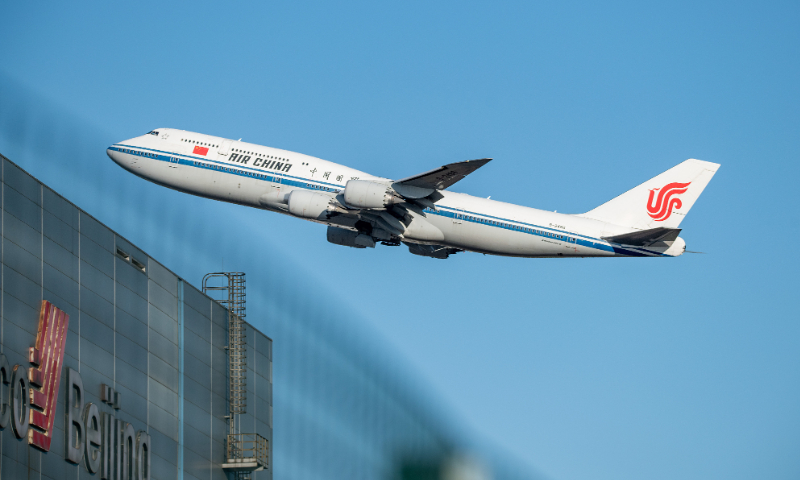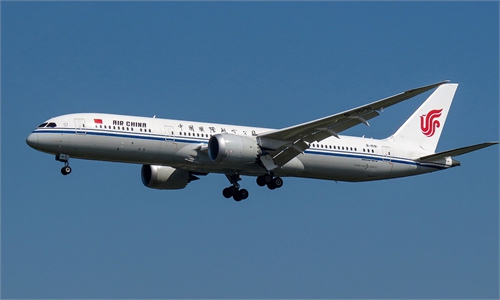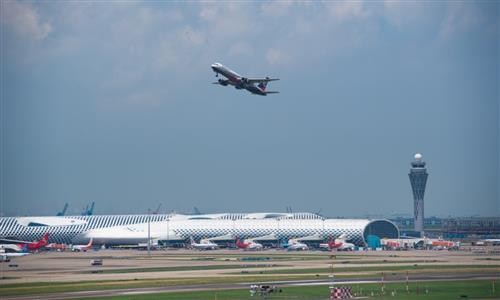
Air China flight CA985 takes off from Beijing Capital International Airport on November 11, 2023, heading to San Francisco International Airport in the US. Photo: VCG
The resumption of flights between China and the US is entering an accelerated phase, which shows how relevant departments of two countries implement, with practical actions, the consensus and vision reached by the leaders at the San Francisco summit. The number of weekly direct roundtrip flights between the two countries only reached double digits in the beginning of this year and has been continuously increasing since May. Currently, there are nearly 70 direct roundtrip flights between China and the US per week and ticket prices have decreased. This is highly welcomed by the societies of both China and the US, and it is also one of the achievements of the restoration and strengthening of high-level communications between the two countries.
The number of direct flights reflects the closeness of people-to-people exchanges between the two countries and serves as a "barometer" of China-US relations. As the two largest economies in the world, China and the US cannot afford to not engage with each other. In fact, facilitating more convenient and cost-effective communication channels is a common desire of the societies in both China and the US. It is not difficult to see that every piece of news about the resumption of direct flights between China and the US has received a lot of attention on social media platforms in both countries. With the gradual restoration of people-to-people exchanges this year, American business giants such as Elon Musk, Bill Gates, and Tim Cook have visited China. This all indicates that it is impossible for China and the US to not engage with each other.
Therefore, as many netizens have pointed out, there are still too few direct flights between China and the US. Compared to the peak period of over 300 flights per week and over 5 million people-to-people exchanges per year between China and the US, there is still a lot of room for growth in the number of flights. During the summit in San Francisco, the Chinese and US leaders agreed to further increase flights early next year and encourage and support more exchanges and communication between the two peoples. China has always been highly efficient in implementing the consensus. It is hoped that the US side will demonstrate efficiency in increasing flights and promoting people-to-people exchanges, which is clearly a win-win area.
The desire for communication and cooperation between the peoples of China and the US has always been strong. With a trade volume of $700 billion and accumulated bilateral investments of over $260 billion, there is a tremendous objective demand for two-way personnel exchanges. The current challenge lies in the fact that these desires and demands were unexpectedly interrupted by the irresistible force of the COVID-19 pandemic. Moreover, some politicians in Washington have rubbed salt in the wound by deliberately suppressing these exchanges. While the interrupted part is relatively easy to restore with changing circumstances, the disrupted and suppressed part by Washington's political actions poses a more complicated challenge. It is this latter aspect that is causing concerns about the state of China-US relations.
The communication between the people of China and the US is constrained by the political relations between the two countries, but it in turn plays a role in promoting the improvement of China-US political relations. Through people-to-people exchanges and cooperation, goodwill accumulates continuously. The reduction and elimination of mutual misunderstandings among the people, and the acknowledgment and expansion of common interests are inevitably converging into an unignorable and undeniable force of public opinion, propelling China-US relations back onto a healthy and stable track. As President Xi Jinping has mentioned, the hope of the China-US relationship lies in the people, its foundation is in our societies, its future depends on the youth, and its vitality comes from exchanges at subnational levels.
Some in Washington don't want to see the restoration of people-to-people exchanges between China and the US. They not only create obstacles in policy but also deliberately target individuals engaged in exchanges, especially Chinese nationals, to undermine the willingness for civilian interactions. Many Chinese individuals traveling to the US have faced unwarranted revocation of visas, questioning at airports, or even detention. This is a result of Washington's growing distrustful, sensitive, and narrow-minded mentality toward China. Cultural exchanges form the social foundation of China-US relations, and the strong desire for mutual interactions between the two societies is hindered significantly by the extreme actions of a small group of politicians in the US. This is regrettable.
China is steadfastly advancing a high-level opening-up to the outside world, including to the US, which is in accordance with the historical trend and a pursuit of win-win cooperation. The Biden administration recognizes that past extreme policies have also harmed the US. Therefore, it has shown an attitude aligned with China in promoting people-to-people exchanges. However, to dismantle the barriers between the societies of China and the US, Washington needs to exert even greater efforts. We hope that the US side can act in accordance with the trend and contribute more positive energy to the stable and healthy development of China-US relations.


